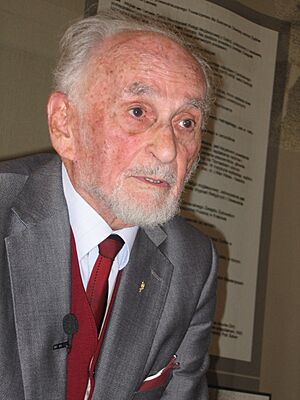Edward Kossoy facts for kids
Quick facts for kids
Edward Kossoy
|
|
|---|---|

Edward Kossoy in Warsaw in May 2007
|
|
| Born | 4 June 1913 Radom, Poland
|
| Died | 11 October 2012 (aged 99) Switzerland
|
| Other names | Marcinak |
| Occupation | Holocaust survivor, Irgun guerrilla; lawyer, attorney, activist, essayist, memoirist |
Edward Kossoy (born June 4, 1913 – died October 11, 2012) was a Polish lawyer and activist. He worked hard to help people who were victims of the Nazis during World War II. He also used the secret name Marcinak during his life.
Contents
Early Life and Education
Edward Kossoy was born in a city called Radom in Poland. When he was a child, his family moved to Yekaterinoslav in the Russian Empire because of World War I.
After the war, in 1921, he moved back to Poland. He finished high school in Radom in 1930. Then, he went to Warsaw University to study law and graduated in 1934.
Life During World War II
In 1939, when Germany invaded Poland, Edward Kossoy fled from Warsaw. He went east to a city called Lviv, which was taken over by the Soviet Union. He hoped to find his family there. He also planned to travel through Romania to France to join the Polish army that was forming there.
In 1940, Soviet police arrested him. He was trying to sell watches to get money for his family and for his journey. Because he had a university education, he was accused of being a spy. He was sent to a forced labor camp, known as a Gulag, in a very cold part of the Soviet Union. He worked on building a railway there.
Life in the camp was very difficult. Edward Kossoy got very sick with a disease called typhus. He was released after two years because of an agreement between Poland and the Soviet Union. He left the Soviet Union with the Anders Army, which was a Polish army formed there.
Sadly, during the war, his father, wife, and daughter were killed by the Germans. Edward Kossoy became very ill with diseases like typhus and malaria, so he had to leave the army in 1943. By the end of 1943, he made his way to the British Mandate of Palestine, which is the area that later became Israel.
In 1944, while in Tel Aviv, he wrote essays about his experiences in the Soviet labor camps. These essays were called Stołypinka, named after the special train cars used to transport prisoners. They were later published as a book in 2003.
After the War
After World War II, Edward Kossoy remarried. His new wife had also been involved in the Warsaw Uprising, a big fight in Warsaw during the war. He lived in Israel until 1954, then moved back to Europe. He continued his studies in Germany and Switzerland, earning a Ph.D. in law and political science.
Friendship in Geneva
In Geneva, Switzerland, he met Wacław Micuta, who had been a member of the Polish resistance group called the Home Army. They became good friends. Micuta told Kossoy about how the Polish resistance had freed people from the Gęsiówka concentration camp during the Warsaw Uprising.
At first, Kossoy was unsure if the story was true. But he decided to investigate and found some survivors of the camp among his clients. They confirmed Micuta's story. Kossoy then wrote several historical articles about this event.
Helping Victims of the Holocaust
As a lawyer, Edward Kossoy helped around 60,000 people who were victims of the Holocaust. He worked to get them money and property back from the German government. His clients included Jewish people, Polish people, and Romani (sometimes called Roma or Gypsies).

